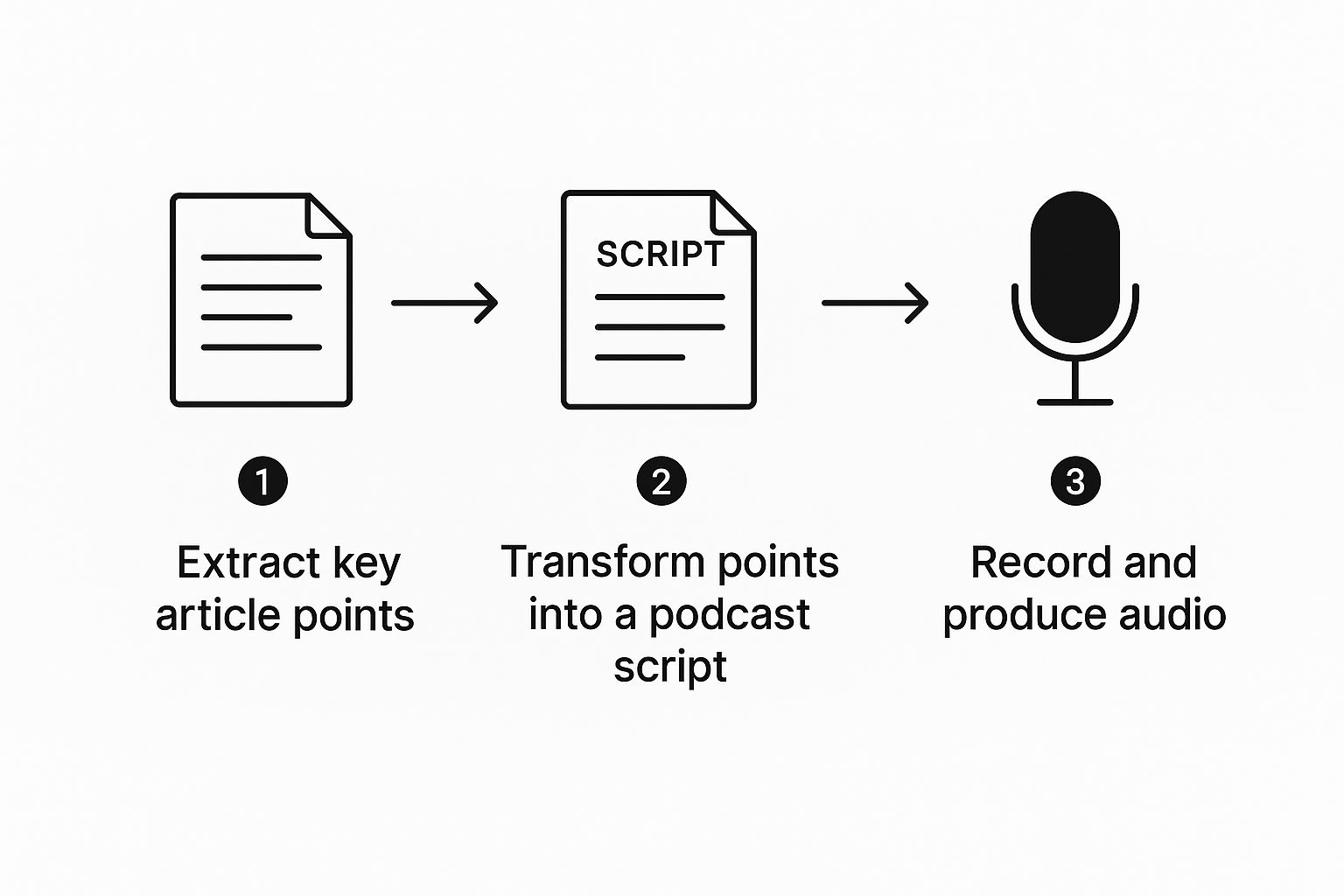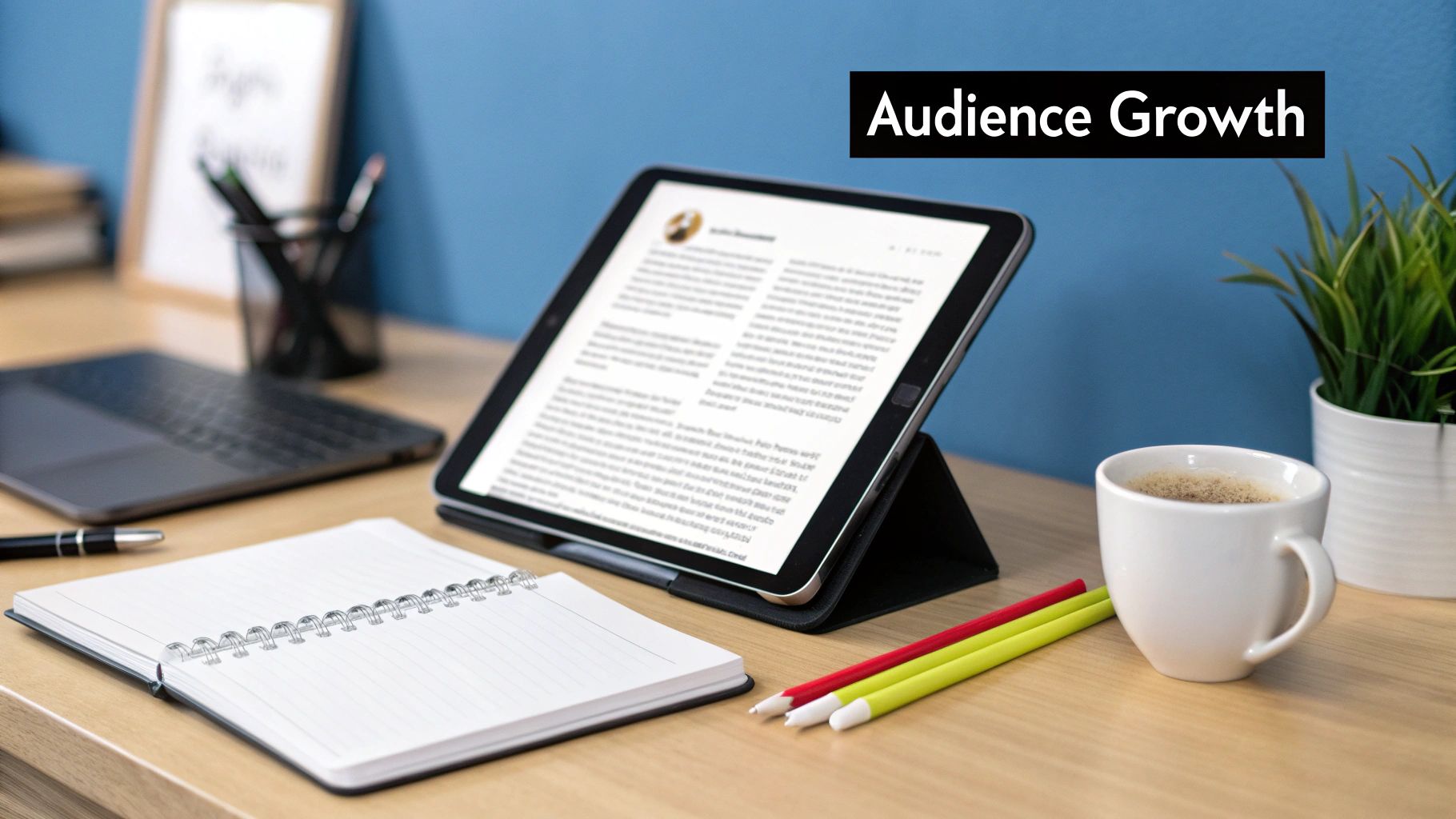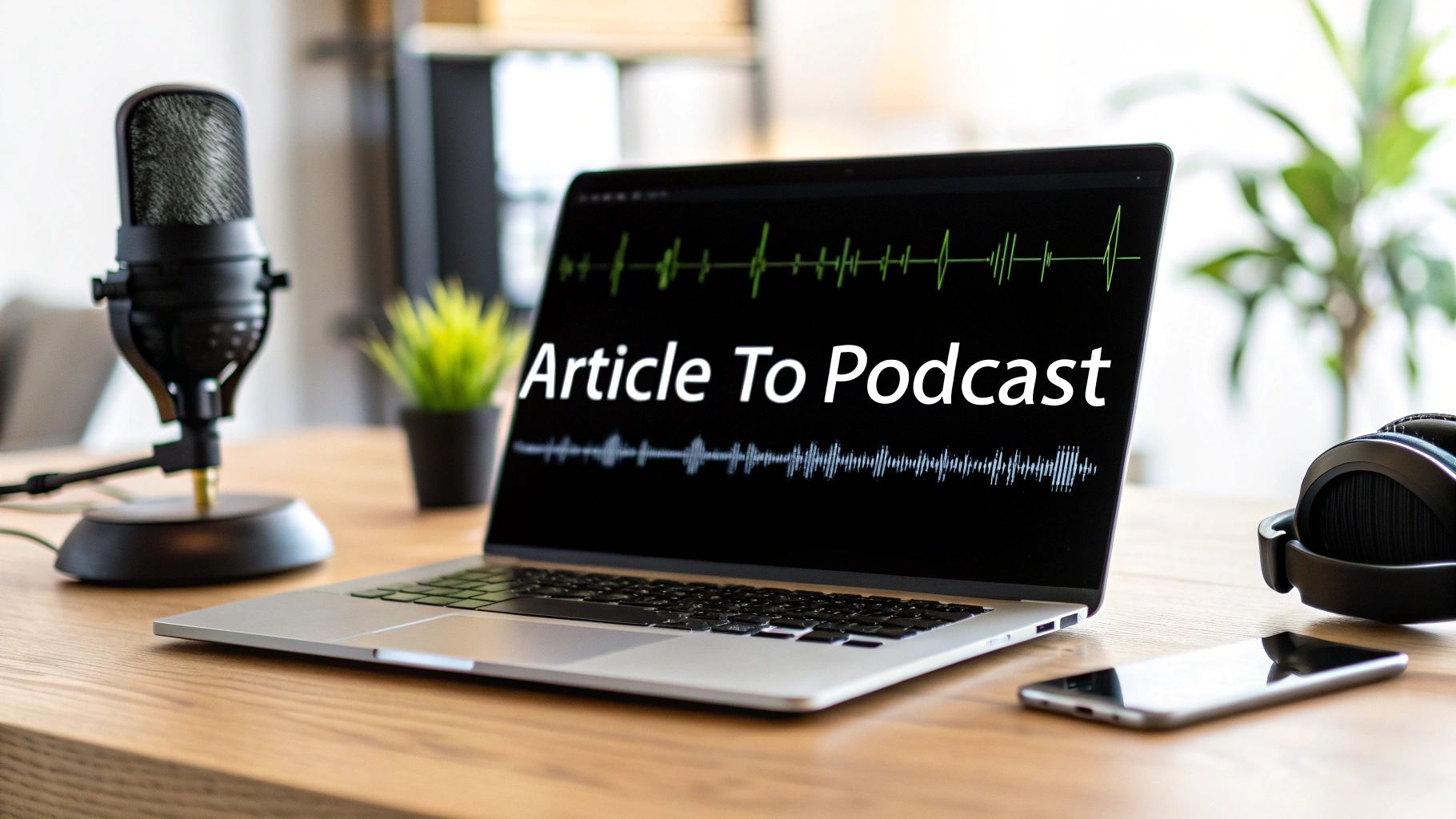Ever thought about giving your best articles a voice? It's a fantastic way to breathe new life into content you've already worked hard on, reaching a whole new audience that prefers to listen rather than read. This isn't about replacing your blog—it's about adding a powerful audio dimension to your content strategy.
Why Your Top Articles Need an Audio Makeover
So your written content is solid, but let's be real, it's fighting for attention in a sea of screens. Converting those articles into audio cracks open a whole new channel for engagement. People can listen while they're driving, working out, or just walking the dog—times when pulling out a phone to read simply isn't gonna happen. You're meeting your audience right where they are, on their terms.
And this isn't some fleeting trend. Podcasting has exploded into a global thing with around 4.4 million podcast titles. The engagement numbers are what really tell the story. Roughly 70% of listeners stick around for most or all of an episode—a level of dedication that's incredibly hard to find with written content.
Forging a Stronger Connection
There's something uniquely personal about audio. When someone hears a human voice (or a really good AI one) explaining a topic, it feels less like an article and more like a real conversation. That's how you build genuine trust and make your brand feel way more human.
Think about the immediate perks:
- True Accessibility: You instantly open your content up to people with visual impairments or those who just absorb info better by listening.
- The Multitasking Advantage: Audio fits perfectly into the nooks and crannies of a busy day, letting your audience consume your content without stopping what they're doing.
- Emotional Resonance: The tone, inflection, and pacing of a voice can bring nuance and emotion to your words, making your message actually stick.
To put it in perspective, let's look at how audio changes the game compared to just text.
Key Benefits of Audio Content vs Written Articles
| Feature | Written Article | Podcast Episode |
|---|---|---|
| Consumption Context | Requires focused visual attention (reading). | Allows for multitasking (driving, exercise). |
| Audience Reach | Limited to readers and screen time. | Taps into the growing audience of audio listeners. |
| Engagement | Measured by time on page, scrolls, comments. | High completion rates (~70%). |
| Personal Connection | Can feel formal and distant. | Creates an intimate, conversational feel. |
| Accessibility | Challenging for visually impaired users. | Easily accessible to a wider audience. |
Ultimately, repurposing your content for audio is a smart, efficient way to get the most bang for your buck.
The best part? The days of needing a professional studio and expensive mics are over. Modern tools can deliver broadcast-quality audio without all the hassle and cost.
This is where you can really make a move without a huge investment. AI-powered tools like our simple article-to-podcast generator take care of all the technical heavy lifting, from narration to final production. This frees you up to do what you're best at: creating fantastic content.
Turning Your First Article Into an AI Podcast
So, you've got a great article and want to give it a voice. Awesome. The best part is you don't need to be an audio expert to turn an article into a podcast. The whole process is surprisingly simple, often starting with nothing more than a link.
With a tool like podcast-generator.ai, the interface is kept clean on purpose. Your main job is just to give the system your content. You’ve usually got two easy options:
- Paste the URL of your live article.
- Copy and paste the raw text right into the editor.
Once you’ve done that, the AI kicks in. It’s doing more than just a simple text-to-speech conversion; it’s actually analyzing your article's structure, pulling out the main ideas, and getting it ready to become a script that sounds like a real person talking.
From Text to First Draft
The initial setup is built for speed. The idea is to get you from a finished blog post to a working audio draft in just a few minutes, taking all the technical headaches out of the equation.
This infographic lays out the core workflow in three straightforward stages.

As you can see, the path from text to audio is a clear progression that does the heavy lifting for you.
The real magic is how the AI structures the narrative. It’s not just a flat reading. It’s about creating a script that flows conversationally, which is exactly what a listener expects.
For instance, the tool might suggest breaking up a long, dense paragraph or rephrasing a sentence so it sounds more natural when spoken aloud. This is also where you can start thinking about your audience. While we're focused on articles here, the same approach works when you want to create an AI podcast from your personal notes, making it a pretty flexible tool.
Remember, you're always in the driver's seat. You get the final say on the script before any audio is actually generated.
Choosing the Right AI Voice for Your Brand

The voice you choose for your podcast is a huge part of its identity. It’s more than just a narrator—it becomes the audio signature for your entire brand. Thankfully, we're well past the era of clunky, robotic text-to-speech. The AI voices available today are shockingly realistic, which means you have a real decision on your hands.
Think about the vibe you're going for. Who is your audience, and what feeling do you want to leave them with? You’re looking for a voice that doesn’t just read your words but actually complements your brand’s personality, making the whole experience feel intentional.
Aligning Voice With Your Content
The right voice makes your content stick. If you're covering complex financial analysis, a calm, authoritative tone builds a sense of trust and credibility. But if you’re walking through an upbeat marketing tutorial, you’ll want a voice with energy and enthusiasm to match.
Let's break it down with a few real-world examples:
- For Educational Content: A clear, steady, and knowledgeable-sounding voice is your best bet. It helps with information retention and keeps people locked in.
- For Storytelling or Case Studies: Go for something warmer and more conversational. This style pulls the listener in and makes the story feel personal and engaging.
- For News and Industry Updates: A crisp, direct, and professional tone conveys credibility and a sense of importance.
My advice? Never just pick the default option. Take a few extra minutes to preview several different voices using a short paragraph from your actual script. Hearing your own words spoken back to you is the quickest way to know if you've found the right fit to turn an article into a podcast.
The real goal here is to make your audience forget they're even listening to an AI. When the voice is a perfect match, it fades into the background, letting your message shine.
Fine-Tuning the Delivery for a Natural Feel
Picking the voice is just the first step. The real magic happens when you start tweaking the delivery to make it sound less like a generated file and more like a person speaking. This is where tiny adjustments can make a huge impact.
Start by playing with the pacing. You might want to slow the speech down just a hair for technically dense sections, giving your audience a chance to process. For more exciting parts, you can bump the speed up slightly.
Strategic pauses are another pro-level tool. Dropping a brief pause right before a key takeaway or after a surprising statistic gives it more weight. These little adjustments break up the rhythm and mimic the natural cadence of human conversation, which is what separates a good AI podcast from a great one.
Fine-Tuning Your AI-Generated Audio

You’ve got a solid audio draft from the AI, which is a fantastic start. But now comes the fun part: adding the professional polish that makes it sound less like a generated file and more like a genuine podcast. This is where you really level up the listener's experience.
The quickest win? Music. A simple intro and outro track instantly frames your content, giving it the structure and feel of a real show. It’s a small touch that adds a huge amount of credibility and consistency.
You don't need to be a music producer, either. There are tons of royalty-free music libraries packed with tracks to fit any mood—whether you're going for high-energy and motivational or something more mellow and reflective.
Quick Enhancements for a Professional Sound
Once you have your music, it’s time for a final audio check. While most AI tools are pretty good at normalizing audio levels, you should always give it one last listen yourself. You're hunting for any awkward pauses or moments where the volume just doesn't feel right.
You’re not trying to become a world-class audio engineer overnight. The goal here is simple: find and fix anything that might pull someone out of the listening experience. Think of it as proofreading, but for your ears.
Your final quality check is all about clarity. A listener should be able to hit play and get lost in your message, not distracted by weird audio glitches.
Before exporting, it’s worth running through a quick mental checklist. This is the last line of defense to make sure you turn your article into a podcast you can be proud of.
- Intro Music: Is the volume right? Does it fade nicely into the main narration without being too abrupt?
- Pacing: Are there any unnaturally long silences between sentences that need to be tightened up?
- Outro Music: Does it fade in at the perfect moment to signal a clean, professional wrap-up?
- Final Listen-Through: Put on some headphones and listen to the entire episode. How does it flow? Does it hold your attention?
When everything sounds on point, it’s time to export. The gold standard for podcasts is the MP3 file. It’s universally compatible, meaning it will work flawlessly on every podcasting platform and app out there.
How to Publish and Promote Your New Podcast

Creating a great-sounding MP3 is a huge win, but it’s only half the battle. Now it’s time to get your new podcast in front of the people who matter most: your audience. Getting your audio heard is what turns a simple file into a powerful content asset.
The first step is distribution. You need to get your episode onto all the major platforms like Spotify and Apple Podcasts. This isn't as complicated as it sounds. You’ll just need a podcast hosting service to store your audio files and create an RSS feed—that’s the special link the directories use to find and list your show automatically.
Spreading the Word to Your Existing Audience
Once your podcast is live, your next move is to tell the audience you already have. This is where you can build some serious initial momentum without spending a dime. Your goal is to make it impossible for your followers to miss your new audio content.
Start right at the source. Go back to the original article and embed a simple audio player at the top. This is a brilliant way to turn an article into a podcast for readers who might prefer to listen while they work or commute.
Next, you'll want to get visual for social media. Static audio files don't really fly on platforms like Instagram or LinkedIn, so you need to adapt.
- Create an audiogram: This is just a short video clip with a background image, a snippet of your audio, and animated soundwaves. They’re highly shareable and give people a taste of the episode.
- Share key quotes: Pull out a powerful quote or a surprising statistic from the episode, turn it into a nice-looking graphic, and share it with a link to the full episode.
Remember, you’re not just announcing a podcast; you’re offering your community a new, more convenient way to consume the content they already love.
Leveraging Email and Beyond
Don’t forget your email list! These subscribers are often your most engaged followers, so they're the perfect group to tell first. Send out a dedicated email announcing the podcast, maybe with a personal note about why you decided to add an audio option, and include direct links to listen.
This multi-channel approach makes sure you reach people where they are. And it’s worth the effort. The podcast advertising world is booming because listeners are so engaged. By 2026, the U.S. market is projected to hit $2.56 billion.
Even more telling, 46% of weekly listeners have bought something they heard advertised on a show. That proves audio is a format that gets people to take action. You can learn more about the rise of podcast advertising on digitalsilk.com.
Your Top Questions About Turning Articles into Audio
So, you're thinking about turning your articles into a podcast. Smart move. But if you're like most people, you probably have a few questions swirling around. Let's tackle them head-on, from one creator to another.
The first two questions I always hear are about time and money. How long does it take? And what’s the damage to my wallet? The good news is, with AI, you’re looking at a matter of minutes, not hours. Forget booking studio time or spending a whole afternoon editing.
And the cost? It’s a fraction of what traditional podcasting would run you. You don't need a fancy microphone or expensive software. The AI does all the heavy lifting, making this one of the most budget-friendly ways to get your voice out there.
But Does an AI Voice Actually Sound Human?
This is the big hang-up for a lot of people, and it's a fair concern. We've all heard those clunky, robotic text-to-speech voices from a decade ago. But the technology has come a long way since then.
Modern AI voices are surprisingly natural. They can handle different tones, from upbeat and energetic to calm and authoritative. They even manage to throw in realistic pauses and inflections that mimic human speech patterns. The key is to find the voice that fits your brand. A tech blog might want a crisp, clear voice, while a wellness article could use something more soothing. My advice? Always listen to a few samples using your own text before you commit.
The goal isn’t to fool anyone. It’s about delivering your valuable content in a clean, professional audio format. When the listening experience is smooth, the content itself becomes the star of the show.
Will This Really Help Me Find a New Audience?
Yes, and it’s a massive one. Podcasting isn't some tiny niche anymore; it’s a mainstream channel people use every single day while commuting, working out, or cooking dinner. Turning your articles into audio lets you slide right into those moments.
The numbers don't lie. Global podcast listenership is projected to hit around 505 million people in 2024, with younger audiences leading the charge. And the whole industry is exploding, with some forecasts predicting it could be worth over $100 billion by 2030. If you want to dive deeper, there are some great podcasting statistics over at explodingtopics.com that really paint the picture.
Think of it this way: adding an audio version to your articles is a simple strategy with a huge potential payoff. You're making your work more accessible and opening up an entirely new channel to connect with people.
Ready to give your best articles a voice? At podcast-generator.ai, you can convert your written content into a professional-sounding podcast in just minutes. Try it for free and create your first episode today!
Article created using Outrank
